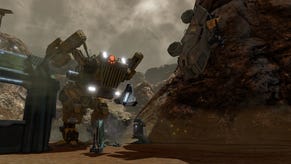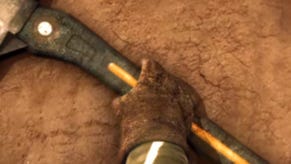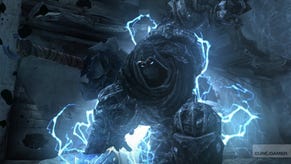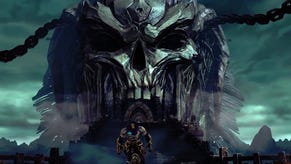Red Faction: Guerrilla's Big Bang Theory
How Volition took destruction to the next level.
One particular challenge facing Volition was that the sheer scope of their destruction model could in many cases overwhelm the Havok code, even when it had been optimised for the target platforms.
"Internally, the destruction system is capable of modelling and processing buildings of super high complexity," Baranec continues. "But if you let a simulation of that fidelity run, it is very easy to get into a situation where you are just presenting the console hardware with too much work to do. So we spent a large amount of time balancing out extreme detail with what the hardware can reasonably do."
Which brings us on to the question of where you draw the line between mathematically correct physics and just how realistic they need to be within the confines what is – at the end of the day – just a game. To what actual level of precision do the calculations have to reach before the effects become basically unnoticeable?
"There is a definitely a diminishing returns curve here, the problem is what is noticeable to the average player is a moving target based on what is happening in game at any particular moment," says Eric Arnold. "Knocking a hole through a wall right in front of your face is a completely different problem than a two story office building collapsing in on itself. We had handle both, and everything in between, without slowing the game down or pulling the player out of the fiction we created."
There's also the concept of you what might call "hero" physics to consider. As the Burnout team will tell you, adhering to reality too closely might well be the mathematically correct thing to do, but it will be to the overall detriment of the game.
"For the most part we stayed as close as possible to reality mainly so things react the way the player expects," admits Arnold. "But the rule was 'this is a game, fun trumps correctness!' The largest example is probably the sledgehammer. Not even the world's strongest man could tear through a wall or send a bad guy sailing the way you can in the game, but that doesn't matter because it feels good and is a whole lot of fun. If we insisted on realism the player would spend half an hour chipping away at a wall to make a small hole (or more likely give up after a few swings because it is boring)."
"One of my favourite phrases about game development is 'we're not making simulations, we're making games'," adds Baranec. "This is often used to chide a young programmer who is trying to get too fancy or complex with a new piece of code. A corollary is 'perception is everything'... what was important was to get a bunch of eye-pleasing objects flying around and crashing into each other in believable ways. Better to have a game than a mathematically correct simulation that takes 30 minutes to render a frame."
Red Faction: Guerrilla came under scrutiny in our recent Face-Off 20 feature, which also featured an extended high definition video showing that Volition's conversion work on both platforms is of a very good quality.
"This was one of our top priorities," admits Eric Arnold. "We knew from the start it would be cross platform even though the PS3 development hardware was still years off when we started. Once we got it and had the game running the two machines moved in lock step to the end of the project... Given how hard we are pushing the systems I'm still impressed that we were able to make them virtually identical, it certainly took a lot of hard work from some very smart people on the team to get there."
In our previous Burnout tech retrospective, Criterion explained its system of "balance points" – the notion of creating a game experience that runs almost identically on multiple systems by taking a holistic view of what each platform is capable of in its entirety. Code was essentially identical regardless of the hardware being targeted. An elegant approach, but while there were similarities in their way of handling things, the Volition guys optimised each platform individually.
"In terms of hardware specifics, the multiprocessing setups on the 360 and the PS3 are significantly different," says Baranec. "At some point, you simply have to diverge big pieces of code to efficiently deal with this. For us, the two big areas here were physics and rendering. Both areas had high level cross-platform frameworks, but when you get to the most performance oriented areas, they did diverge into totally platform specific code. Thankfully, the volume of code this represents of the overall codebase is very small."
Keeping the two platforms at the same level of performance did however incur several sacrifices from the team.
"We went as far as cutting optimisations because they would only work on one platform," reveals Arnold. "For our own sanity we tried to keep the internals as close as possible, but with the SPUs we had to do custom solutions at the time for performance reasons. For destruction, I had to physically remove functionality and code from Havok in order to make room for our system on the SPUs."
"Generally speaking, we like to keep both platforms developing in parallel. You can't really afford to let one platform slip behind because then it becomes difficult to make predictions about overall performance and features," adds Dave Baranec. "Which then impacts the ability to create assets, which then impacts the schedule, which then impacts the budget, etc."
Regardless of the challenges working with the current generation consoles brought about, the fact is that Volition and the GeoMod engine will be around for a long time yet – with the principles and fundamental technology now established, it will scale up to the next generation and even beyond. And for those lamenting the passing of the terrain deformation in the original GeoMod, there is hope it may return.
"In terms of an improved feature set, anything is possible," reckons Baranec. "The original GeoMod engine was a boolean solid operation engine, which made it ideal for terrain modification. While this is a distinct piece of functionality from GeoMod 2.0, there's nothing inherently stopping them from being rolled together into one world... What I find really exciting is that the tech is trivially expandable as hardware improves. The core system is capable of doing much more than you see in RFG. What limits us currently is how much rigid body simulation modern hardware can do. In that sense, the engine is very much a mean nasty dog that we have to keep leashed... for now."
Red Faction: Guerilla is out now for both Xbox 360 and PlayStation 3, with DLC announcements due imminently. A PC version is set for release on Friday, August 28.
Do you want to know more? The Digital Foundry channel is updated frequently with new technology stories and performance analyses. The full transcript of our interview with Volition will be running next week.













